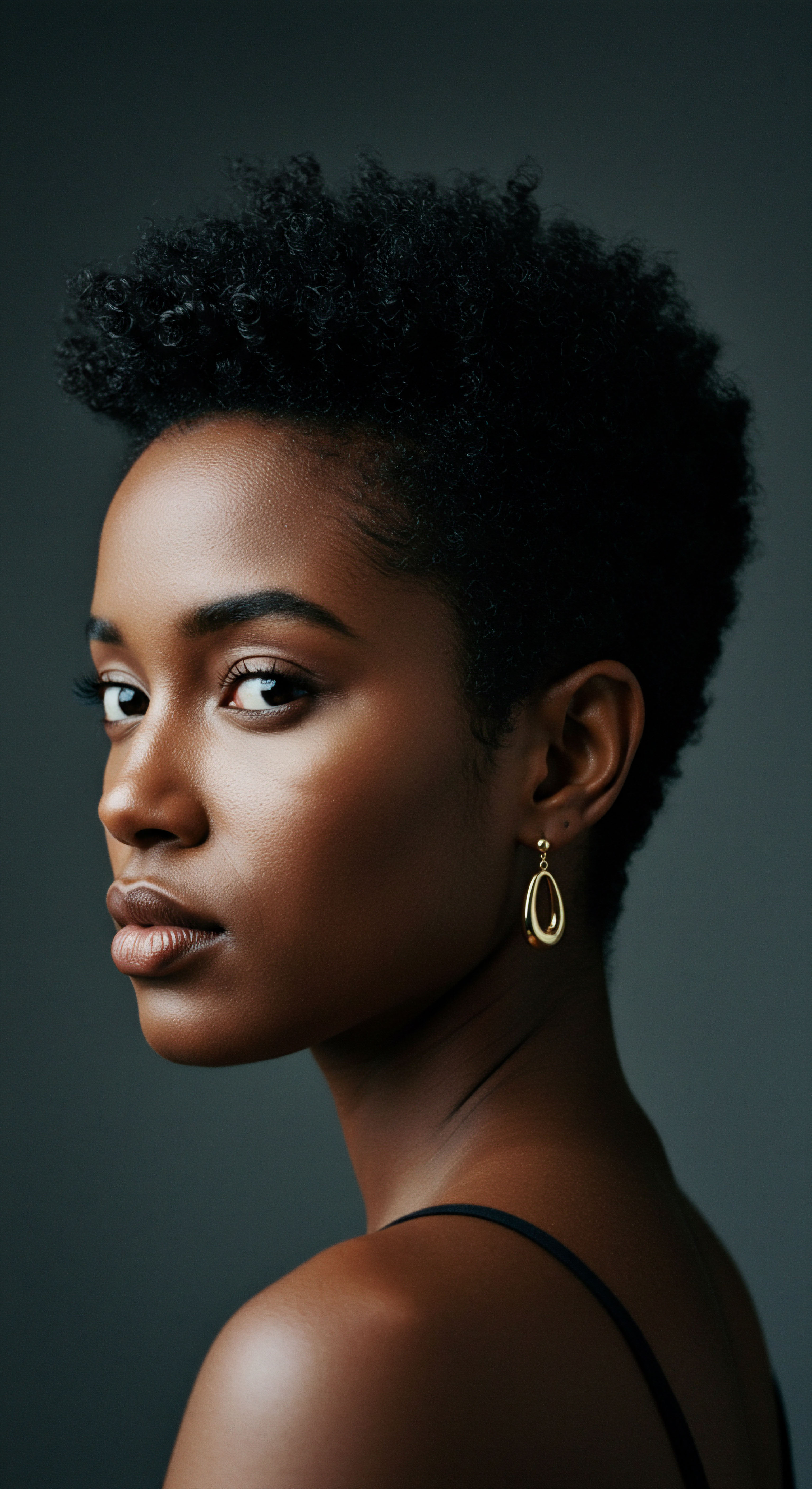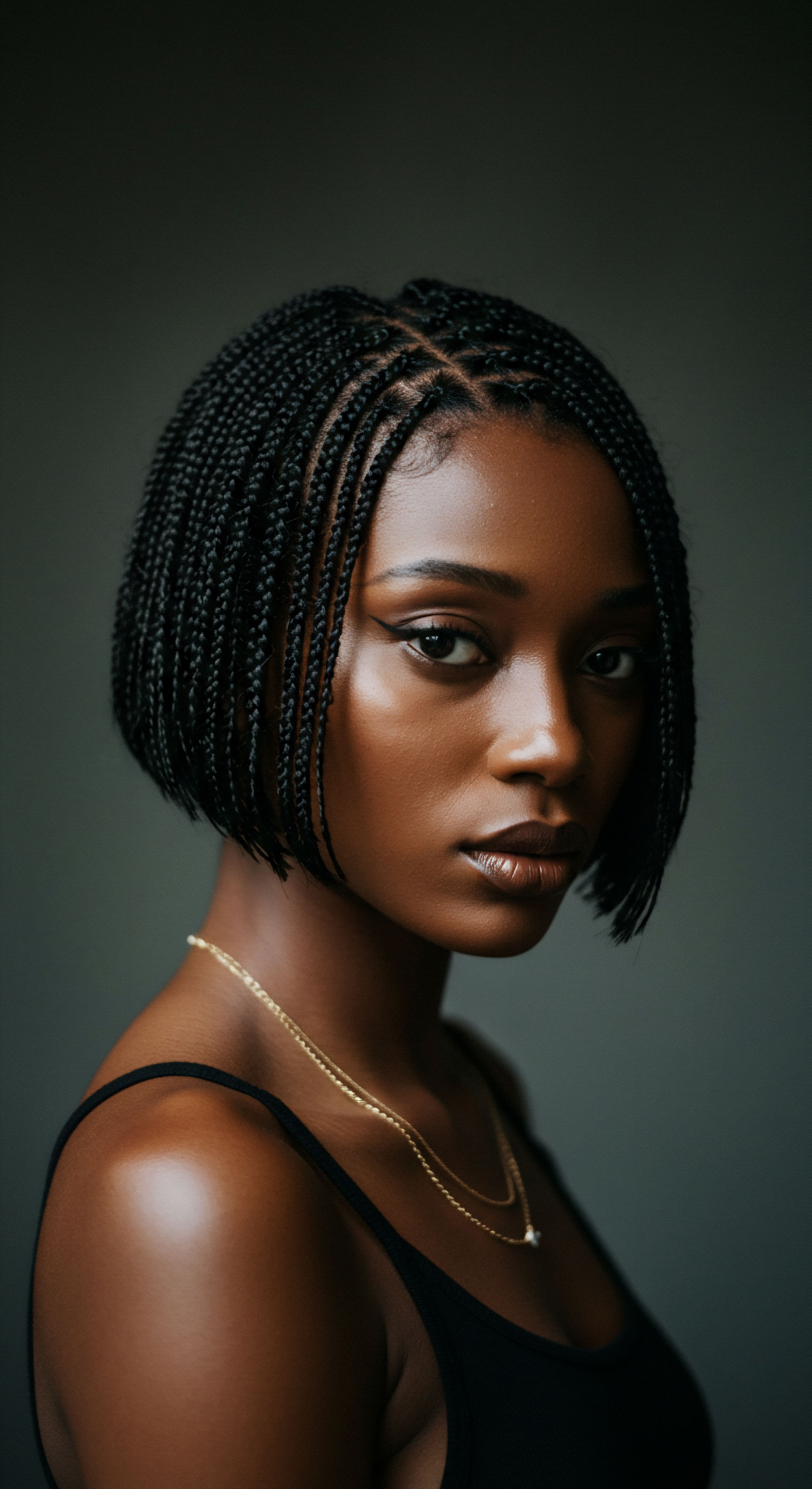
Roots
The quiet hours of night, a time for rest and rejuvenation, often hold an unspoken tension for those with textured hair. As we drift into slumber, a silent question lingers ❉ does our chosen nighttime ritual truly shield our strands from the rigors of friction and moisture loss? This inquiry reaches beyond simple product application; it delves into the very architecture of hair, its ancient lineage, and the subtle dance between our bodies and the world around us.
Understanding the fundamental nature of textured hair, its unique structure and inherent needs, provides the grounding for any meaningful conversation about its protection. It is a dialogue rooted in respect for natural design and the pursuit of sustained vitality.

The Architecture of Textured Hair
At its core, textured hair possesses a distinct structural makeup that sets it apart. Unlike straight strands, which tend to have a more uniform, circular cross-section, coily and curly hair often exhibits an elliptical or even flattened shape. This morphological variation is not merely cosmetic; it influences everything from how light reflects off the hair, contributing to its unique luster, to its susceptibility to breakage. The bends and curves along the hair shaft, while beautiful, create points of vulnerability where the protective outer layer, the cuticle, can lift or become compromised.
The Cuticle, composed of overlapping, scale-like cells, acts as the hair’s primary defense. When these scales lie flat and smooth, the hair feels soft, appears shiny, and retains moisture effectively. However, the very nature of textured hair’s twists and turns means that these cuticle scales are inherently more exposed to external forces. Each curve presents an opportunity for friction to disrupt the cuticle’s integrity, leading to a cascade of effects that compromise the hair’s health and appearance.
Textured hair’s unique structural characteristics, particularly its varied cross-sectional shape and natural bends, inherently increase its vulnerability to external stressors like friction.

Understanding Hair’s Innate Properties
Hair is primarily composed of keratin, a strong, fibrous protein. This protein gives hair its strength and elasticity, allowing it to stretch and return to its original state. However, this elasticity has limits.
When hair is subjected to repeated mechanical stress, such as rubbing against rough surfaces, its internal protein bonds can weaken, leading to damage. This damage often begins at the cuticle, manifesting as lifted scales, which then expose the inner cortex to further harm.
The natural oils produced by the scalp, known as sebum, play a vital role in maintaining hair health. Sebum travels down the hair shaft, providing a natural coating that helps seal the cuticle and impart shine. For textured hair, the journey of sebum from scalp to tip is often more challenging due to the hair’s coiled structure.
This can result in drier strands, particularly at the ends, making them even more prone to friction-induced damage and moisture loss. This inherent dryness means textured hair has a greater need for external protection and moisture retention strategies.

The Essential Lexicon of Textured Hair Care
To truly understand the dialogue surrounding textured hair care, a common language becomes necessary. Terms like Porosity, Density, and Elasticity are not mere jargon; they are descriptive markers that inform personalized care.
- Porosity refers to the hair’s ability to absorb and retain moisture. Hair with high porosity has widely open cuticles, allowing moisture to enter and exit quickly, often leading to dryness. Low porosity hair has tightly closed cuticles, making it difficult for moisture to penetrate but easy to retain once absorbed.
- Density describes the number of individual hair strands on the scalp. High density hair appears thick and full, while low density hair appears thinner. This impacts styling choices and product application.
- Elasticity measures the hair’s ability to stretch without breaking. Healthy hair has good elasticity, allowing it to withstand manipulation. Hair with poor elasticity is more brittle and prone to breakage.
These characteristics, combined with the hair’s natural curl pattern, shape its unique requirements. A bonnet, in this foundational context, emerges as a potential ally, a simple yet effective tool designed to work in concert with the hair’s inherent properties, safeguarding its delicate structure against the unseen nightly aggressors.

Ritual
As the day draws to a close and the world settles into its nightly rhythm, many with textured hair engage in a deliberate, almost sacred, preparation for rest. This nightly ritual is more than just a routine; it is a conscious act of care, a protective measure against the unseen forces that can diminish the vitality of our strands during sleep. The question of whether sleeping with a bonnet truly protects textured hair shifts from a theoretical consideration to a practical one, seeking to understand the tangible benefits this practice offers. It is a journey into the applied wisdom of hair preservation, where technique meets intention.

The Nighttime Sanctuary Essential Sleep Protection
The hours spent asleep, while seemingly passive, can be quite active for our hair. Tossing and turning, shifting positions, and the constant friction against bedding materials can inflict considerable damage. Cotton pillowcases, ubiquitous in many homes, possess a relatively rough surface at a microscopic level.
As textured hair, with its natural bends and coils, rubs against these fibers, it experiences mechanical stress. This friction can lead to a phenomenon known as Cuticle Lifting, where the protective outer scales of the hair shaft are raised, much like shingles on a roof in a storm.
When the cuticle is lifted, the hair becomes more vulnerable. It loses moisture more readily, leading to dryness and brittleness. It also becomes more prone to tangling and knotting, as the raised cuticles snag on one another.
This is where the bonnet steps in as a guardian. By encasing the hair within a smooth, low-friction environment, it creates a protective sanctuary, significantly reducing the direct contact between delicate strands and abrasive surfaces.

Choosing the Right Material Does Fabric Selection Matter
The effectiveness of a bonnet hinges significantly on its material. Not all fabrics offer the same level of protection. The prevailing wisdom, supported by experiential accounts and scientific understanding, points towards silk and satin as superior choices.
- Silk a natural protein fiber, boasts an incredibly smooth surface. Its low coefficient of friction allows hair to glide over it with minimal resistance. This reduces the mechanical stress that leads to cuticle damage, tangling, and breakage.
- Satin while typically a synthetic weave (often polyester), mimics the smooth texture of silk due to its specific weaving pattern. It provides a similar low-friction environment, making it an accessible and effective alternative for hair protection.
- Cotton, by contrast, is highly absorbent and has a coarser fiber structure. It can wick away the hair’s natural moisture and cause significant friction, leading to dryness, frizz, and breakage.
The choice of material directly influences the degree of protection offered. A bonnet made of silk or satin creates an optimal sleeping environment for textured hair, preserving its moisture and structural integrity.
| Material Type Silk |
| Surface Texture Very smooth, low friction |
| Moisture Interaction Non-absorbent, helps retain moisture |
| Impact on Hair Minimizes breakage, frizz, maintains shine |
| Material Type Satin (Polyester) |
| Surface Texture Smooth, low friction |
| Moisture Interaction Less absorbent, helps retain moisture |
| Impact on Hair Reduces breakage, frizz, maintains style |
| Material Type Cotton |
| Surface Texture Rough, high friction |
| Moisture Interaction Highly absorbent, wicks away moisture |
| Impact on Hair Increases breakage, frizz, dryness, tangles |
| Material Type Selecting the right material for a bonnet is paramount for effective hair protection during sleep. |

Maintaining Moisture and Style Overnight
Beyond physical protection from friction, bonnets play a critical role in moisture retention. Textured hair, by its very nature, tends to be prone to dryness. Cotton pillowcases, as mentioned, are highly absorbent and can draw moisture directly from the hair strands, leaving them parched and brittle by morning. Silk and satin, being less absorbent, allow the hair to retain its natural oils and any applied conditioning products, keeping it hydrated throughout the night.
This moisture preservation contributes significantly to overall hair health and appearance. Hydrated hair is more elastic, less prone to breakage, and maintains its style better. For those who invest time in defining curls or setting protective styles, a bonnet helps to preserve the integrity of these efforts, extending the life of a style and reducing the need for daily manipulation. This reduction in daily styling can, in itself, lessen the cumulative stress on the hair.
A well-chosen bonnet, particularly one made of silk or satin, acts as a moisture guardian, preventing the nightly depletion of vital hydration from textured strands.
The consistent use of a bonnet transforms the nightly routine from a potential source of damage into a restorative period. It allows hair to rest undisturbed, its delicate structure shielded from abrasive forces, its moisture balance maintained. This simple act of wearing a bonnet becomes a powerful component of a holistic hair care regimen, contributing to healthier, more resilient textured hair over time.

Relay
Moving beyond the immediate and observable benefits, the deeper question of whether sleeping with a bonnet truly protects textured hair invites us into a more complex scientific and cultural dialogue. This conversation transcends anecdotal evidence, seeking grounding in the precise mechanisms of hair damage and the historical wisdom embedded in hair care practices. It compels us to consider the microscopic interplay between hair and its environment, and how cultural traditions have long anticipated modern scientific findings in their pursuit of hair preservation. The effectiveness of a bonnet, viewed through this multifaceted lens, reveals layers of understanding that reinforce its profound value.

The Microscopic Battle Against Friction Does Bonnet Material Reduce Hair Fiber Damage
At the heart of a bonnet’s protective capacity lies its ability to mitigate friction. To truly grasp this, we must consider the hair fiber at a microscopic level. The outermost layer of each hair strand, the cuticle, is composed of overlapping cells, akin to shingles on a roof. These cells, when healthy, lie flat, creating a smooth surface that reflects light and seals in moisture.
When hair rubs against a rough surface, such as a cotton pillowcase, these cuticle scales can lift, chip, or even break. This mechanical abrasion compromises the hair’s structural integrity, leading to a host of visible issues ❉ frizz, dullness, tangling, and ultimately, breakage.
Research into the mechanical properties of hair, as detailed in foundational texts like Clarence R. Robbins’s Chemical and Physical Behavior of Human Hair, consistently highlights how the friction generated between hair fibers and rough surfaces can lead to significant cuticle disruption and subsequent protein loss, far exceeding the minimal friction experienced with smoother materials. This principle is critical to understanding why bonnets made of certain materials are so effective.
A study published in the Journal of Cosmetic Science, for example, demonstrated that hair fibers experienced significantly less damage when rubbed against silk compared to cotton. This direct scientific observation underscores the tangible difference in material interaction at the fiber level.
The reduction in friction provided by silk or satin bonnets minimizes the opportunity for these micro-abrasions. When hair glides rather than snags, the cuticle remains undisturbed, preserving its smooth surface and protective function. This is not merely about preventing a bad hair day; it is about safeguarding the very building blocks of healthy hair against continuous, low-level trauma that accumulates over time.

Preserving Hair’s Hydration A Scientific Perspective
Beyond mechanical protection, bonnets play a significant role in maintaining hair’s moisture balance. Hair, particularly textured hair, has a unique relationship with water. Its coiled structure makes it inherently more susceptible to moisture loss compared to straight hair, as natural oils struggle to travel down the entire length of the strand. Cotton, a hydrophilic material, readily absorbs water.
When hair rests on a cotton pillowcase for hours, the fabric acts like a sponge, drawing out the hair’s natural moisture and any applied conditioning products. This leads to dry, brittle strands that are more prone to breakage.
In contrast, silk and satin are hydrophobic, meaning they repel water. They do not absorb moisture from the hair in the same way cotton does. This property allows the hair to retain its essential hydration throughout the night. The continuous preservation of moisture is vital for maintaining the hair’s elasticity and strength.
Hydrated hair is pliable and less likely to snap under stress, whether from daily styling or environmental factors. This sustained hydration contributes to the hair’s overall resilience and vitality, reducing the need for excessive moisturizing products or daily rewetting, which can themselves contribute to mechanical stress.

The Cultural Echoes of Nighttime Hair Protection
The practice of covering hair for sleep is not a modern invention; it resonates with a rich history of cultural traditions, particularly within Black communities. For generations, headwraps, scarves, and later, bonnets, have been essential tools for preserving textured hair. These practices arose from an intuitive understanding of hair’s needs, long before the advent of scientific instruments capable of observing cuticle damage or quantifying friction coefficients.
These traditions reflect a deep respect for hair as a symbol of identity, beauty, and heritage. They were practical solutions born from lived experience, passed down through families, serving to protect intricate styles, maintain cleanliness, and shield delicate strands from environmental aggressors, including the nightly friction of bedding. The modern bonnet, in many ways, is a continuation of this ancestral wisdom, a contemporary expression of timeless care. It bridges the gap between traditional practices and scientific validation, affirming that what was once known through observation and experience is now understood through the lens of material science and hair biology.
The use of bonnets for hair protection during sleep represents a convergence of ancestral wisdom and contemporary hair science, both recognizing the critical need to shield textured hair from nightly stressors.

Beyond the Bonnet The Broader Ecosystem of Hair Health
While bonnets offer significant protection, their efficacy is amplified when considered within a broader ecosystem of hair health. They are a powerful tool, but not a standalone solution. The state of one’s hair is influenced by a complex interplay of factors, including internal health, nutrition, and other care practices.
- Internal Health ❉ Diet, hydration, stress levels, and hormonal balance all play a role in the health of hair growing from the follicle. A balanced diet rich in proteins, vitamins, and minerals provides the building blocks for strong hair.
- Gentle Detangling ❉ Even with a bonnet, gentle handling during detangling is crucial. Starting from the ends and working upwards with a wide-tooth comb minimizes breakage.
- Moisture Routine ❉ Regular conditioning and moisturizing with appropriate products ensure the hair remains hydrated throughout the day, complementing the bonnet’s nightly moisture retention.
The bonnet, then, becomes a vital component in a holistic approach to textured hair care, working in concert with other practices to promote resilience and vibrancy. Its contribution to reducing mechanical damage and preserving moisture is scientifically sound and culturally affirmed, solidifying its place as a cornerstone of nighttime hair protection.

Reflection
As the discourse around textured hair care continues to deepen, the humble bonnet stands as a testament to both intuitive wisdom and scientific validation. Its presence in our nightly rituals is more than a fleeting trend; it is a quiet affirmation of care, a protective gesture that echoes through generations. The journey of understanding its true impact has led us through the microscopic landscape of hair fibers, the subtle mechanics of friction, and the enduring legacy of cultural practices.
What emerges is a clear recognition that safeguarding our strands during sleep is not a trivial pursuit, but a fundamental act of preserving their inherent strength and radiant beauty. The bonnet, in its simplicity, offers a profound connection to the vitality of textured hair, a silent promise of serenity for the strands as the world sleeps.

References
- Robbins, C. R. Chemical and Physical Behavior of Human Hair. 5th ed. Springer Science & Business Media, 2012.
- Yu, P. S. et al. Surface characterization of human hair by atomic force microscopy and friction force microscopy. Journal of Cosmetic Science, 2007.
- Wortmann, R. P. et al. Hair damage due to grooming and environmental factors. Journal of Cosmetic Science, 2000s.
- International Journal of Trichology. Hair fiber morphology under scanning electron microscopy, 2018.
- Schwartz, A. M. & Knowles, D. C. Frictional properties of hair. Journal of the Society of Cosmetic Chemists, 1963.
- Bhushan, B. et al. Friction dynamics of straight, curly, and wavy hair. Journal of Applied Physics, 2014.
- El-Messiry, M. et al. Effect of fabric type on hair damage due to static charge accumulation. Textile Research Journal, 2017.
- Kaushik, V. Chogale, R. & Mhaskar, S. Alternative Protocol for Hair Damage Assessment and Comparison of Hair Care Treatments. International Journal of Trichology, 2020.